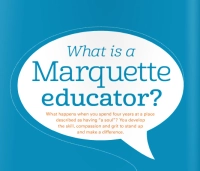 As part of Dr. Melissa Gibson’s class Teaching Middle Secondary Social Science, students are asked to think about social studies in a new light — and throughout the course, their perceptions do shift. Through their blogging during the semester, we can see these changes in the students’ own words. Read on to learn along with our students!
As part of Dr. Melissa Gibson’s class Teaching Middle Secondary Social Science, students are asked to think about social studies in a new light — and throughout the course, their perceptions do shift. Through their blogging during the semester, we can see these changes in the students’ own words. Read on to learn along with our students!
By Elie Ortiz
The first eight years of my life were spent in Puerto Rico. It was a place where everybody spoke Spanish. I was comfortable — comfortable talking to my parents, extended family, friends, and teachers. But all of a sudden, my life took a huge turn. I was no longer in Puerto Rico; I was sitting in a classroom where everybody spoke English. At the time, I knew about three words: door, window, pencil.
Social studies was a drag. I was forced to memorize vocabulary words such as “allegiance” and “sovereign.” I might know what they mean now, but when I was a little girl I didn’t, and I was traumatized by my entire social studies experience. All of the kids around me knew what they were talking about; they constructed arguments, they debated, and seemed like experts in the subject. Me? I was struggling to even form a sentence in my head just to ask the teacher about a homework assignment.
By high school, I was fluent in English, but I was definitely not fluent in social studies. I still hated it. It dragged just as much as it did in elementary school. Why? Because social studies was never taught beyond the books. We did not go out to explore our community, there were no guest speakers, and our readings were bland. While we did more inquiry and took informed action, I still had a negative attitude about social studies until college. I never loved social studies until now, all thanks to my amazing professor. As it turns out, social studies is not just about world wars and looking at historical documents. It’s about learning about ourselves, our community, our world — using our knowledge to question the world and take action. It’s about the impact each individual person can have on the world.
***
I am not telling you my story so you can feel sorry for me about my experience with social studies. Rather, it’s to emphasize the importance of teaching our kids to be sociologists, geographers, historians. Students, especially during their younger years, are curious about the world. If we lecture them, have them take notes, then give them tests all of the time, are we really impacting our students? No. We are teaching them what to think, not how to think.
Overall, my thinking about social studies in K-8 classrooms has changed tremendously throughout the semester. At first, I viewed social studies as only boring history facts, but now I see it as a powerful tool to help students not only succeed in school but as human beings as well. The C3 Framework presents the following four Dimensions: Developing questions and planning inquiries; Applying disciplinary concepts and tools; Evaluating sources and using evidence; and Communicating conclusions and taking informed actions. These dimensions can be applied in the classroom and in the real world as well.
For example: Let’s think about poverty. Why are people living in poverty? How is poverty affecting our economic status? What is the data? How many people live in poverty today? What can I do to stop poverty?
As we can see, we can apply what we learn in the classroom into the real world and actually make a difference. As educators, let’s impact our students through social studies. Every single student deserves to learn about how powerful it can be.









